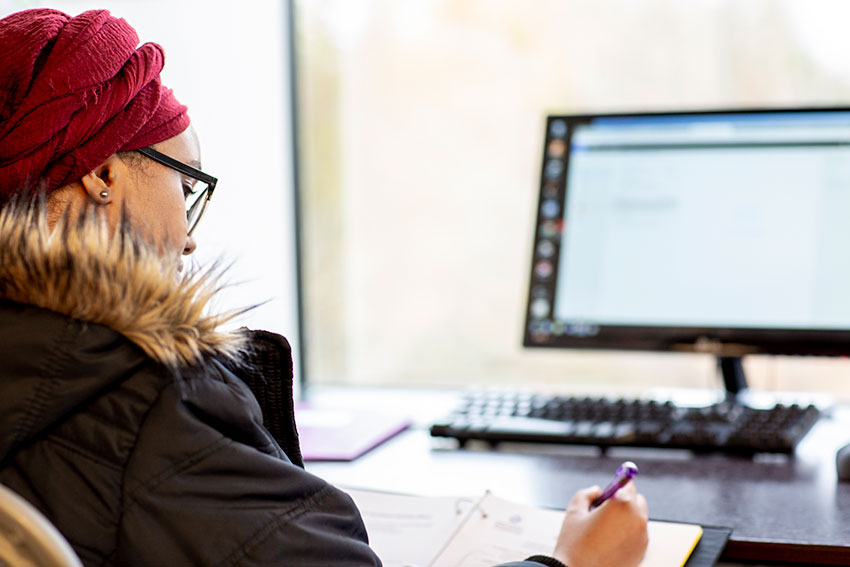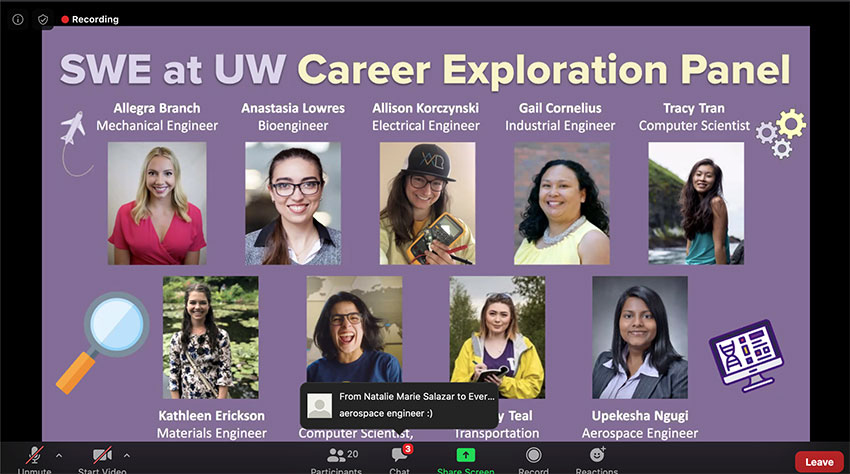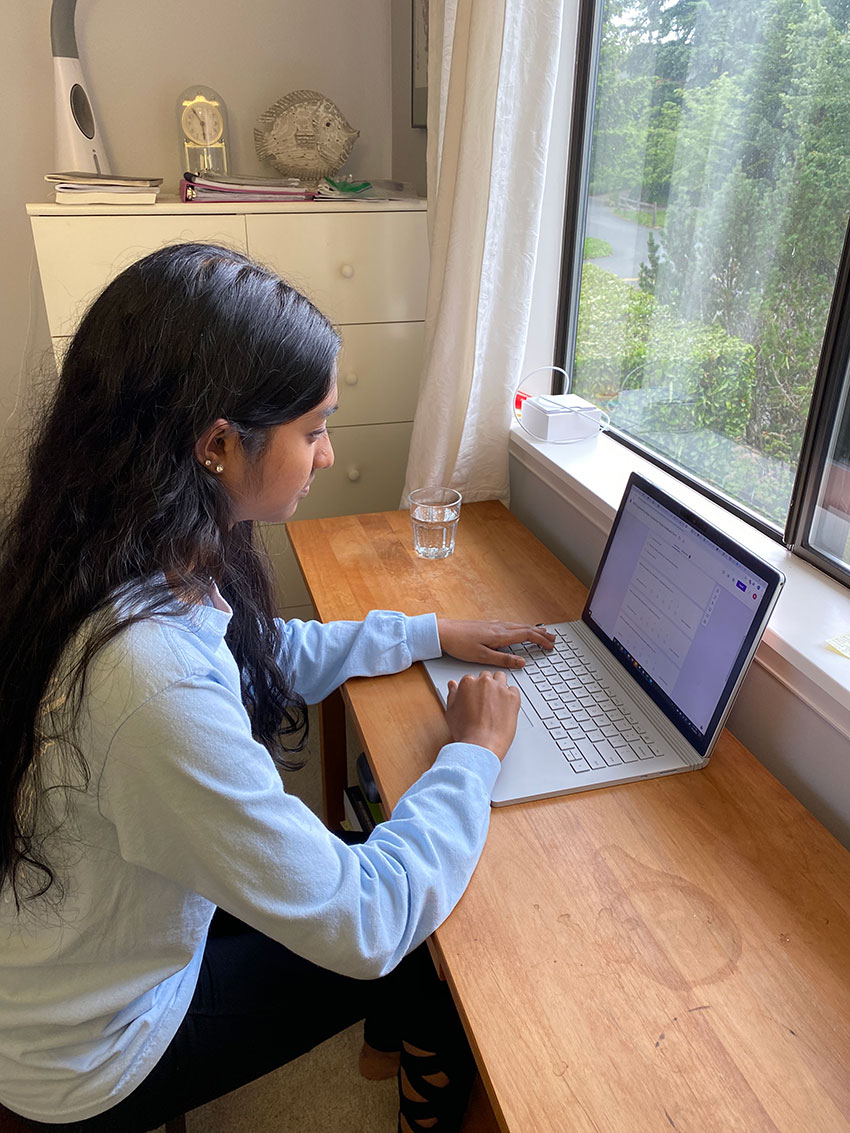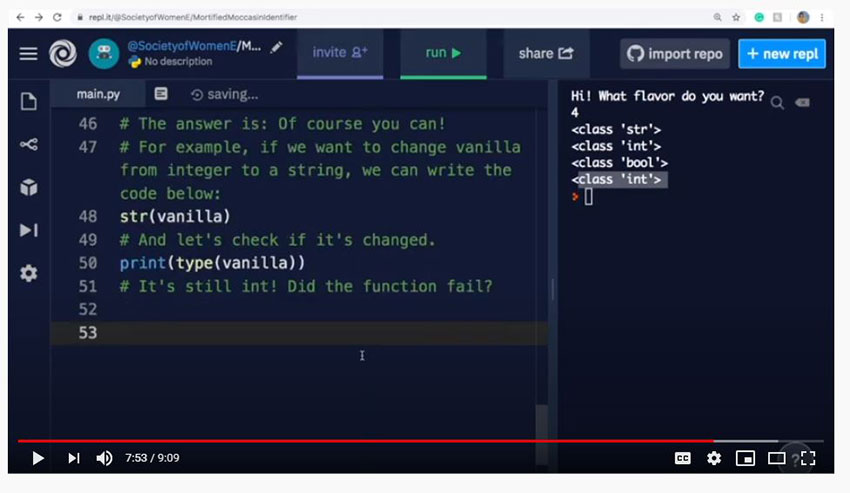By Sarah McQuate and Chelsea Yates
When Natalie Salazar learned that the UW would be moving spring classes online to align with Washington’s “Stay Home, Stay Healthy” order, she knew that the Society of Women Engineers at UW (SWE)’s plans for the rest of the year would be dramatically impacted.
Founded in 1950, the Society of Women Engineers is a non-profit educational service organization for women in engineering and technology. Professional and student chapters such as the UW’s are located throughout the world. Membership is open to both women and men. Learn more at swe.org
The UW chapter includes about 470 total members, 26 of which are active in K-12 outreach efforts.
“Our chapter typically hosts coding classes, introduction to engineering workshops and career panels for Seattle-area middle and high school students who might not have access to STEM (science, technology, engineering and math) programs through their own schools,” explains Salazar, who graduated in June with an electrical engineering degree. This past year, she served as SWE’s vice-president of community outreach.
Like other UW organizations, SWE had to cancel in-person programs at the end of March, so Salazar called SWE’s volunteer team together to decide on next steps.
“There were about 20 engineering students on the call,” she remembers. “I asked them if they wanted to take a step back and process or if they wanted to keep working, and everyone said they wanted to keep moving forward. Our discussion immediately pivoted from ‘Should we keep working?’ to ‘What can we do virtually?’ It was extremely inspiring, and it lit a fire under me.”
Developing a mentorship program

SWE's virtual programs allow students to work from home at times that are convenient and flexible.
“We’d wanted to launch a mentorship program for a while — to work more regularly with high school students interested in engineering,” Salazar continues. “To be honest, it had seemed like a pretty big undertaking but by late March everything seemed like a big undertaking so we thought, why not now? After all, high school students, like UW students, were at home.”
Though SWE members were comfortable talking about engineering and explaining what engineers do, they realized that mentorship required different skills and that developing those skills would be a unique opportunity. They reached out to GEAR-UP, a college access program active in several south King County school districts that is part of a national effort to help students from low-income families prepare for and succeed in higher education.
“Our GEAR-UP partners had connected us with local schools in the past, and they agreed to help train our college mentors to be receptive and culturally sensitive to mentees,” says Brittan Robinett, a computer science major who will be leading SWE’s community outreach activities now that Salazar has graduated.
SWE also reached out to other college access programs active on campus, such as Making Connections, offered through the UW Alene Moris Women’s Center.
“For us, the timing couldn’t have been better,” says Kristy Hansen, STEM enrichment coordinator for Making Connections. “Unfortunately we lost some of our volunteers once the stay-at-home order went into effect, but almost seamlessly we were able to fill that gap by connecting our high school students virtually with SWE.”

This spring, SWE hosted virtual career panels for students to learn about different types of engineering from women working in industry. The speakers explained their career areas, shared their pathways to engineering and answered questions from students.
SWE officially launched their virtual mentorship program, which they named Forward with SWE, at the beginning of spring quarter with 22 high school student mentees and 19 SWE student mentors. Throughout the quarter, they worked in small groups based on interests and backgrounds. The mentoring groups connected weekly by Zoom to discuss topics, such as engineering major options, potential careers, how to pay for college and how to set personal goals.
“We decided to create small mentoring groups instead of pairing students one-on-one with a mentor so that they could feel better supported and explore engineering areas more broadly,” Robinett explains.
 “I joined because I wanted to see if engineering was the right path for me. Both my SWE mentors, Caleigh and Iman, have been super understanding and have given me tons of resources to show me how broad of a field engineering is and how it can fit with the type of job I want to have in the future. Even beyond engineering they’ve taught me so much about good choices to make in college like joining clubs, finding internships and networking. It’s been a really eye-opening experience for me, and I’m grateful for my mentors for helping me figure out my goals.” – Mandira, 15 years old
“I joined because I wanted to see if engineering was the right path for me. Both my SWE mentors, Caleigh and Iman, have been super understanding and have given me tons of resources to show me how broad of a field engineering is and how it can fit with the type of job I want to have in the future. Even beyond engineering they’ve taught me so much about good choices to make in college like joining clubs, finding internships and networking. It’s been a really eye-opening experience for me, and I’m grateful for my mentors for helping me figure out my goals.” – Mandira, 15 years old
Remote engagement and accessibility

In addition to launching new programs, SWE moved pre-existing programs online. “Although we wish we could have seen our students in person, we enjoyed interacting with them online this quarter!” says computer science major Nayha Auradkar, who is leading SWE Explore remotely.
In addition to creating this new program, many of SWE's regular outreach programs also transitioned online. SWE Explore, an engineering exploration program that usually involves on-site visits to middle schools, instead produced a video series and held two virtual career panels so students could learn more about different types of engineering from women working in those areas. And in lieu of in-person coding workshops, the team launched a series of short videos to teach students how to code in Python, called SWE Code. These videos are available on SWE’s YouTube channel.
“A live stream like Zoom can create barriers if students don’t have reliable internet access, but videos can be downloaded and watched when it’s convenient for students,” says Simona Liao, an engineering student who heads up SWE Code.
SWE is continuing its online and virtual programs through the summer. Though the group hopes to return to in-person activities in the future, they acknowledge the value of digital engagement and plan to continue it even as on-campus activities resume.
“Online programs allow students to participate from anywhere,” Liao explains. “Getting to campus can be a challenge for students, especially those who live in south Seattle. This way, they don’t need to spend hours traveling to and from an event. They can participate in ways that work for them.”

SWE Code, a series of short videos created by SWE members, teaches students how to code in Python.
Plus, she adds, they have the potential to reach more students than just those in the room during an in-person event: “Though we created our Python coding video series with middle schoolers in mind, we know of high school students who are watching them. Recently one of our students mentioned that her fourth-grade sister has been using them to learn to code, which is great.”
Not only is SWE connecting with more students across Seattle, but the program is also expanding at the UW. Even after pivoting to online, SWE’s outreach team grew. “We gained six new volunteers since the end of winter quarter,” Salazar says. “That brought our total to 26, which is pretty impressive if you consider that in spring 2019 we had fewer than ten.”
“I think it shows that people want to be connected, and they want to help — especially in times of uncertainty,” she adds. “After all, we’re engineers and problem-solvers.”
Learn more about how to get involved with SWE’s outreach programs.
Originally published July 6, 2020